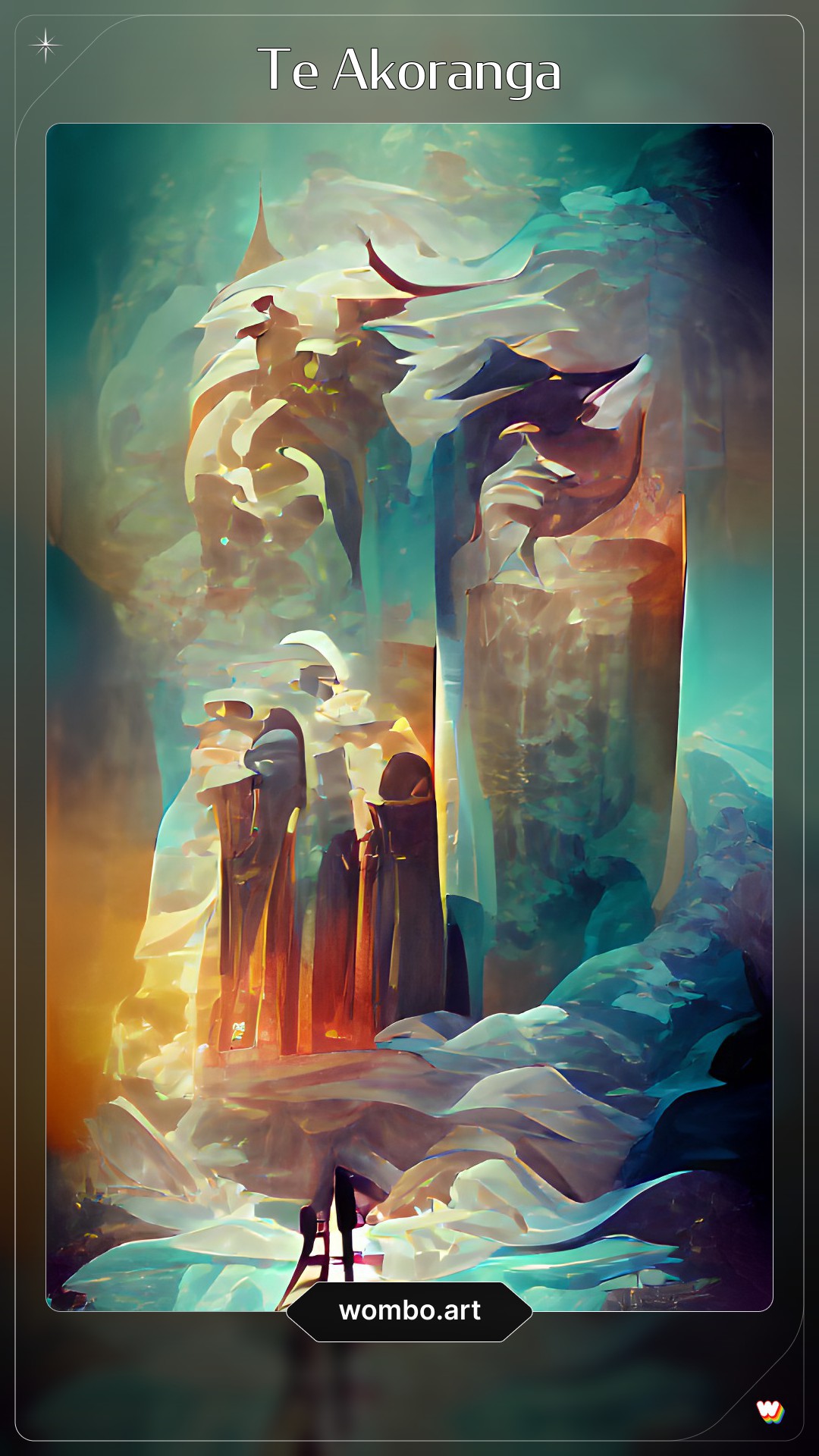Te Akoranga
The Four Pillars of Hesli
Te Akoranga believes that the world was constructed using four primary categories they call pillars. Each pillar represents an important part of the world and has a main deity. Every pillar is then comprised of four smaller branches that each contribute to that particular pillar.- Healing & Medicine
- Animals
- Plants
- People
- Mountains
- War
- Resources
- Soil
- Moon
- Ocean
- Rivers
- Ice
- Wind
- Clouds
- Light
- Energy
Pillar of Life
Main Article: Pillar of Life
The pillar of life primarily focuses on everything regarding life on the planet. The deities of this pillar take care of the living through people, animals, and plants. Healing is an important part of this pillar as it can prolong life in some cases. The temples of life are usually in the woods or open plains near creeks and wild life. Typically, these temples have lush gardens and wild life walking at the premise. Furthermore, nearly all the cities have a monastery since they partially function as a hospital.Pillar of Earth
Main Article: Pillar of Earth
The pillar of earth represents the land of the planet itself. This pillar provides the ever stretching mountain ranges and the neverending plains with its rich resources. It is also on land where wars rage and thus where the deity of war shines its light upon the victorious. The temples of earth are often located in the mountains or near the foot of one. Sometimes, it is hard to distinguish a temple from a stronghold as they often function as a residence for nearby villages during restless times.Pillar of Water
Main Article: Pillar of Water
The pillar of water is everywhere around the planet as it represents all forms. Using the moon and the ocean, it explains the tides. It takes care of the rivers flowing through the land to ensure enough water reaches the soils for growing crop and animals. In the far north, the ice captures life into an eternal state giving an interesting habitat to new and unexplored territory for the dwarves. Naturally, temples of water often reside alongside lake or ocean shores and river banks.Pillar of the Sky
Main Article: Pillar of the Sky
The pillar of the sky controls the weather on the planet. The wind carries the clouds filled with water over the lands and oceans, giving water to places where the pillar of water cannot reach immediately. The light allows everyone to see and perceive the world, whereas energy controls the temperature all over the world. When too much energy builds up, the wind and clouds take it with them to release the fury over the soil in form of thunderstorms. Finding temples of the sky is no easy task as many stand on high peaks. Monasteries are closer to the ground and easier to reach.The Road to Akori
An Akori is a follower of Te Akorange in general, and identify themselves as such when they believe in the concept of the pillars. It is normal to worship multiple deities and their respective branches within Te Akorange, hence why most dwarfs use Akori. Only priests, temple guardians, and deity guardians use branch specific identification, since they are closely tied to that branch. However, a dwarf usually does not become an Akori overnight.
Early Years
Dwarfs learn at a very young age the basics of Te Akorange from their parents. Many take their children to monasteries and temples to educate them about their believes. From these trips, the children learn what the several branches mean and what each deity does. There are even organised summer camps where a group of dwarves take these children around all the temples from the major and minor deities.Pilgrimage
The final stage before truly becoming an Akori is the pilgrimage. Most adolescent dwarfs travel to the House of Regin to pay their respects to the main deities. Up to this point, they haven't partaken in any religious activities for themselves, such as offerings. The times they were taken to these activities were usually because of the parents. However, at this stage of their life, it is time for an adolescent dwarf to walk Te Akoranga themselves. During this pilgrimage, it is customary for the pilgrim to try and visit the temples, and sometimes monasteries, of all the minor and major deities. They deem it important to at least learn one more time about all the deities and gather further knowledge about their origins and the tasks at hand. Depending on where the dwarf starts their pilgrimage and their dedication, it could take anything from 70 to 120 days of traveling before reaching the House of Regin. Once they reach the main temple, they stay at the adjacent monastery for as long as they require. In this time, they pray and process what they have learned thus far. They are free to wander the monastery and temple grounds to find priests of all disciplines and ask them further questions regarding their specific branch. Many also roam the streets of the capital in search of people performing the profession they desire to execute. With the combined knowledge from these professionals and the priests, they finally decide which branches they want to worship. This choice is not set in stone and they can change it anytime they like.Unspoken Fifth Pillar
Main Article: Pillar of Darkness
According to ancient texts, there used to be a fifth pillar in the creation of the world: the Pillar of Darkness. A sect has formed around this unspoken pillar, worshipping the deities of his branch. These deities are:- Hemonga - Deity of Death
- Malim - Deity of Demons
- Fanas - Deity of the Void
- Phiana - Deity of Poison
The Pillar of Darkness is not to be feared! Yes, it deals with the things that we dislike, but everyone dislikes them. However, don't you want your dead to travel safely to the realm of eternal slumber? Don't you want demons to be kept at bay? Don't you want the void to stay away from our beautiful world and avoid poisoning it? Yes, our deities can be used for evil, but so can the deities from the four pillars of the world. It is all about the context you give to them and what you ask of them.There aren't many sects that truly distinguish themselves from Te Akoranga. The sect surrounding the Pillar of Darkness has always been highly frowned upon by most Akori. However, in recent years, more dwarfs have come to understand that the unspoken fifth pillar is not as bad as it seems. Still, there is little known about the fifth pillar. All information so far has come from dwarfs who have left the sect.
eòlas annad fhèin tha gliocas

Pillar of Life
Pillar of Earth
Pillar of Water
Pillar of the Sky Major Deity
Ljef - Deity of Life
Ogalthr - Deity of the Earth
Vjakr - Deity of Water
Hrym - Deity of the Sky Minor Deity
Pillar of Life
Duran - Deity of Healing
Karar - Deity of Animals
Tipu - Deity of Plants
Vanhu - Deity of Folks Pillar of Earth
Gomo - Deity of Mountains
Hondo - Deity of War
Raymi - Deity of Resources
Pamu - Deity of Soil Pillar of Water
Ghea - Deity of the Moon
Cuan - Deity of the Ocean
Abhain - Deity of Rivers
Deigh - Deity of Ice Pillar of the Sky
Gao - Deity of the Wind
Yea - Deity of the Clouds
Aitro - Deity of the Light
Luth - Deity of Energy
Remove these ads. Join the Worldbuilders Guild







Ah, interesting! Something different than the usual dwarfish religions :D I'm curious about one of their pillars being related to the sky and weather! As dwarfs are usually underground critters, it doesn't come up much in their lives - are these dwarfs more surface dwelling?
Creator of Araea, Megacorpolis, and many others.
Thank you! Yes, these dwarfs are more surface dwelling. There are of course still dwarfs living underground and mining, but there are also many living in the valleys farming and breeding animals. ^^